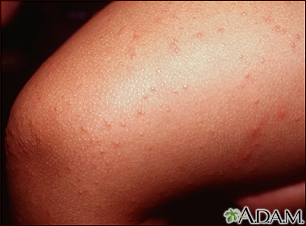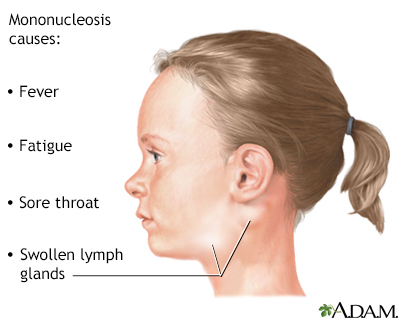Gianotti-Crosti syndrome
Definition
Gianotti-Crosti syndrome is a childhood skin condition that may be accompanied by mild symptoms of fever and malaise. It may also be associated with hepatitis B and other viral infections.
Alternative Names
Papular acrodermatitis of childhood; Infantile acrodermatitis; Acrodermatitis - infantile lichenoid; Acrodermatitis - papular infantile; Papulovesicular acro-located syndrome
Causes
Health care providers don't know the exact cause of this disorder. They do know that it is linked with other infections.
In Italian children, Gianotti-Crosti syndrome is seen frequently with hepatitis B. But this link is rarely seen in the United States. Epstein-Barr virus (EBV, mononucleosis) is the virus most often associated with acrodermatitis.
Other associated viruses include:
- Cytomegalovirus
- Coxsackie viruses
- Parainfluenza virus
- Respiratory syncytial virus (RSV)
- Some types of live virus vaccines
Symptoms
Skin symptoms may include any of the following:
- Rash or patch on the skin, usually on the arms and legs
- Brownish-red or copper-colored patch that is firm and flat on top
- String of bumps may appear in a line
- Generally not itchy
- Rash looks the same on both sides of the body
- Rash may appear on the palms and soles, but not on the back, chest, or belly area (this is one of the ways it is identified, by the absence of the rash from the trunk of the body)
Other symptoms that may appear include:
- Swollen abdomen
- Swollen lymph nodes
- Tender lymph nodes
Exams and Tests
The provider can diagnose this condition by looking at the skin and rash. The liver, spleen, and lymph nodes may be swollen.
The following tests may be done to confirm the diagnosis or rule out other conditions:
- Bilirubin level
- Hepatitis virus serology or hepatitis B surface antigen
- Liver enzymes (liver function tests)
- Screening for EBV antibodies
- Skin biopsy
Treatment
The disorder itself is not treated. Infections linked with this condition, such as hepatitis B and Epstein-Barr, are treated. Cortisone creams and oral antihistamines may help with itching and irritation.
Outlook (Prognosis)
The rash usually disappears on its own in about 3 to 8 weeks without treatment or complication. Associated conditions must be watched carefully.
Possible Complications
Complications occur as a result of associated conditions, rather than as a result of the rash.
When to Contact a Medical Professional
Call your provider if your child has signs of this condition.
Gallery


References
Bender NR, Chiu YE. Eczematous disorders. In: Kliegman RM, St. Geme JW, Blum NJ, Shah SS, Tasker RC, Wilson KM, eds. Nelson Textbook of Pediatrics. 21st ed. Philadelphia, PA: Elsevier; 2020:chap 674.
Gelmetti C. Gianotti-Crosti syndrome. In: Lebwohl MG, Heymann WR, Berth-Jones J, Coulson IH, eds. Treatment of Skin Disease: Comprehensive Therapeutic Strategies. 5th ed. Philadelphia, PA: Elsevier; 2018:chap 91.